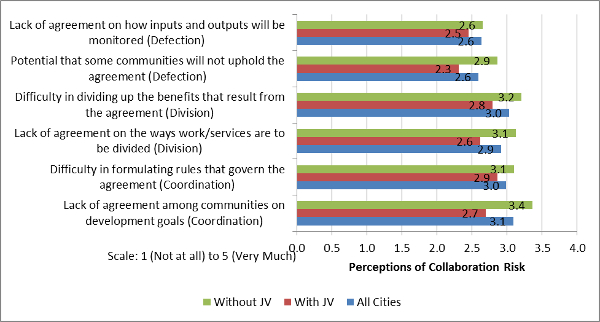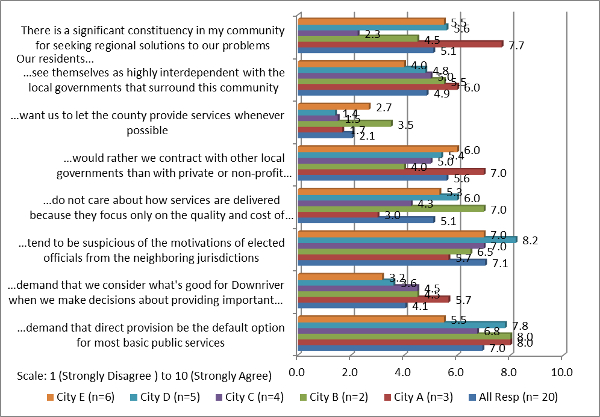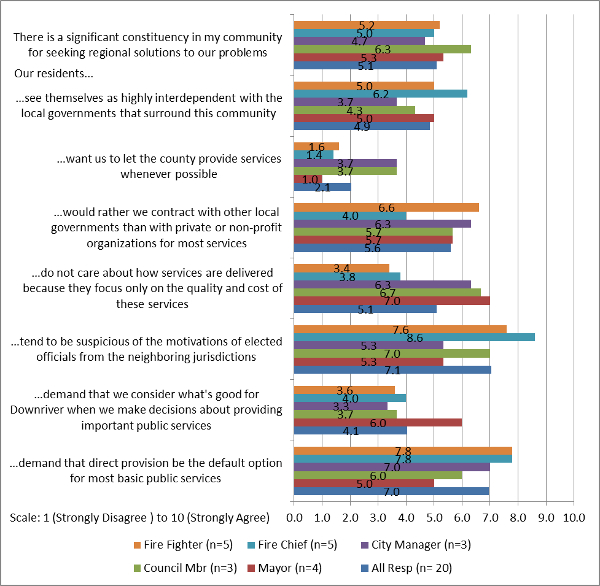 In the U.S. and across the world, city governments now face a period of fiscal constraint with declining tax revenues and an increased demand for services. One potential solution to this problem has been for cities to pool resources by introducing shared services agreements. Jered B. Carr takes a close look at such collaborative arrangements, and warns that while they may seem attractive, policy makers need to be aware of the potential risks which can stem from coordination costs, difficulties in dividing benefits, and the potential for one of the parties to not comply with the agreement.
In the U.S. and across the world, city governments now face a period of fiscal constraint with declining tax revenues and an increased demand for services. One potential solution to this problem has been for cities to pool resources by introducing shared services agreements. Jered B. Carr takes a close look at such collaborative arrangements, and warns that while they may seem attractive, policy makers need to be aware of the potential risks which can stem from coordination costs, difficulties in dividing benefits, and the potential for one of the parties to not comply with the agreement.
Local governments in the United States face a “new normal” in which revenue growth is severely constrained, demands for services are expanding, and their workforces are shrinking. Delivering high quality services within these constraints is a serious challenge for many officials in local government. Popular discussions about how these problems might be solved often emphasize the potential for cost reductions from increasing the scale of operations in each city and eliminating redundant activities across neighboring municipalities through various forms of shared service agreements. These arrangements include contracting for services from other governments, the creation of multijurisdictional service authorities, and a host of other formal and informal arrangements to produce local public services with other governments.
Proponents of these arrangements often express dismay that collaborative service arrangements are not more widespread. To some, the absence of service arrangements to jointly provide or otherwise share services indicates a lack of accountability to residents and a desire by local officials to protect their service “fiefdoms”. Yet this perspective ignores the risks to local governments from sharing service production responsibilities with other organizations, whether other governments, NGOs, or for-profit firms, and the costs involved in reducing these risks to manageable levels. The polycentric nature of U.S. regions creates more opportunities for local governments to share services, but also increases potential risks because of the large number of potential partners, diversity of issues requiring collective action, and the complexity of service arrangements.
Three Basic Forms of Collaboration Risk
Officials from participating governments must overcome risks from problems of coordination, division, and defection. These costs arise at different points in the process and underscore that the participants face ongoing risks from collaboration, particularly from defection. In the most general sense, each source of risk depends on differences in the preferences of residents in the cities participating in the agreement and the relative ability of their governments to bias the agreements in favor of their own residents. It is important that policymakers, analysts, and government administrators understand the sources of these risks and the factors affecting their severity.
Risks due to Coordination Costs
Simply coming together to share services carries risks to the participating governments. Officials from each government must develop agreements that address the needs of their own diverse populations while also supporting the service delivery goals of the group. Intergovernmental agreements usually require approval from each city council, and depending on the nature of the transactions, several rounds of negotiation and bargaining may be required to determine the terms and conditions of the agreements. Overcoming these coordination costs requires specifying who will be involved in the agreement, the role each participant will play, and how and when required activities are to be undertaken.
Clear differences among local governments in the preferences of residents for services and taxes are expected to increase the costs of coordinating potential partners and these costs usually increase with the size of the group. Differences in the fiscal condition of the government and the wealth and income of its residents is seen as an indication of differences in the capacity of these governments to support residential demands for services.
Risks due to Division Costs
Division problems arise when local governments encounter difficulty in dividing and distributing the expected benefits among the group. They may agree on the general goals for the collaboration, but fail to agree on the distribution of joint benefits and the required inputs into the arrangement. When a proposed distribution of resources or benefits from a joint venture is perceived to benefit some participants at the expense of others, the generation of collective benefits is at risk. Participants may be willing to accept returns that deviate from their ideal levels, but the risk of defection increases as the gap grows.
Many of the same factors that increase coordination costs are likely to also increase division problems. Differences in political power, policy preferences, resource levels, and demographic composition are key factors. Division costs are also likely to be affected by the production characteristics of the project or service to be jointly provided. Capital-intensive services may create unequal partners when one or more of the cities are large enough to achieve much of the cost savings on their own. These power differentials will usually be less important in the case of labor-intensive services because cooperating cities are on more equal footing when it comes to their own production costs.
Risks due to Defection Costs
Defection problems emerge when at least one party does not comply with the agreement. In essence, each participant must be confident that the others have a commitment to fulfill their obligations and will support the underlying goals and objectives of the agreement over time. Shirking imposes costs on those who have already invested their time and resources in the collaboration.
Research on defection risks generally focuses on the role that asset specificity and measurement difficulty play in creating incentives for participants to renege on their commitments by hiding their true performance or by threatening to withdraw from the agreement. Highly asset-specific services require specialized investments that cannot easily be redeployed to provide other services. Easily measured services have readily identifiable performance metrics that help to ensure vendors meet all their obligations in delivering the service. Both of these sources of defection risk might be mitigated to some extent through adaptive contracts, but research often focuses on the role of social networks in overcoming credible commitment problems. For example, tightly clustered structures encourage trust by increasing information about partners, helping to reduce the costs of enforcing and monitoring informal and formal agreements.
Perceptions of Collaboration Risk by City Officials
Considerable energy has been directed at identifying and describing these three forms of collaboration risk, but far less is understood about how government officials perceive these risks. This is because few studies have sought to produce direct measures of how local government officials perceive collaboration risks. Hawkins developed a set of survey questions intended to produce measures of the collaboration risk involved in joint ventures perceived by economic development officials in municipal governments in the U.S. Hatley surveyed twenty municipal officials to measure their perceptions of how the residents of their cities viewed the risks of sharing services with neighboring communities. These two studies show how these broad conceptions of risk can be translated into more routine concerns that can be identified and measured.
Christopher Hawkins surveyed the director of economic development or planning in each local government in twelve metropolitan areas in the U.S. regarding the creation of joint ventures for economic development purposes and their perceptions of the collaboration risk in their region accompanying the kinds of ventures. He sought their general perceptions of the barriers to collaboration on a broad range of joint ventures intended to encourage development and improve economic and fiscal conations in the region. The survey covered 37 different development initiatives, including regional promotion, land acquisition and assembly, job training for the local workforce, and tourism development. The initiatives covered by the survey vary widely in the resources required from potential partners and the benefits anticipated from the venture.
Figure 1: Development Officials’ Perceptions of Collaboration Risk in Joint Ventures in their Region (from Hawkins 2009)

Figure 1 shows the questions Hawkins used to measure their perceptions of the risk from coordination, division, and defection costs and the mean levels reported by the 158 respondents. The development officials in cities lacking joint ventures perceived the costs of collaboration to be higher than their counterparts from cities with joint ventures. The differences between the two groups “on agreement on development goals” and “dividing up the resulting benefits” are especially large. Given the conflict that often arises over competition for economic development, these findings are not surprising, but what do they tell us about how their views of collaboration risk affect the creation of joint ventures? These findings might suggest that the collaboration risk perceived by their development officials is why these cities did not form any joint ventures. Alternatively, they might indicate that involvement in economic development joint ventures generates trust among the participants and this leads to perceptions of lower collaboration risk by officials from these governments. Both interpretations have support in the research literature.
Figure 2: Perceptions of Residents’ Attitudes toward Collaboration Risk Reported by Officials from Five Cities in Southeastern Michigan [by City](from Hatley, 2010)

The second study is William Hatley’s examination of the efforts by five suburban communities in the Detroit metropolitan area to create a regional authority to replace their five separate fire departments. In contrast to Hawkins’ study, Hatley’s research focused on a single potential collaboration: the creation of a multi-community fire and emergency medical services (EMS) authority. These five communities have very similar demographics and a long history of cooperation on firefighting through a system of mutual aid that permits each city to call on its neighbors when help is needed. In 2006, the five fire chiefs and several elected and appointed officials from the cities began to meet regularly to discuss the feasibility of expanding their existing collaboration to include joint provision of fire services and EMS. The effort was strengthened the following year when a feasibility study funded by the State of Michigan reported the creation of a single fire authority providing services to all five cities would reduce their costs by approximately 20 percent, while simultaneously improving the quality of the services provided to residents. Hatley interviewed twenty city officials actively involved in this effort in the fall of 2007 to examine their motivations for seeking the fire authority, their perceptions of the benefits of the joint venture, and their perceptions of the attitudes of their city’s residents about intergovernmental cooperation among the five cities. The effort continued until 2009, when the group formally suspended the project. Hatley’s follow up interviews with several members of the group indicated that retirements by key administrators and the election of new leadership in several cities greatly reduced the interest of these cities in joining a fire authority.
Figures 2 and 3 report their perceptions of the attitudes of their residents toward intergovernmental cooperation on public services. Hatley’s questions do not comprehensively address the different forms of collaboration risk, but his survey effectively illustrates the differences in these perceptions across the cities and among the different categories of decision makers. Figure 2 shows large differences among the cities in the attitudes these officials attribute to their residents. Despite the highly similar racial and economic compositions of the five cities, their official often had highly dissimilar views about what they thought their residents supported. Given these differences, it is likely that their perceptions of the collaboration risk from this project also differed.
Figure 3: Perceptions of Residents’ Attitudes toward Collaboration Risk Reported by Officials from Five Cities in Southeastern Michigan [by Role] (from Hatley, 2010)

Finally, Figure 3 reports their responses aggregated by the role each respondent played in city government. The creation and successful implementation of a shared service agreement involves elected officials, senior managers and the professional administrators who deliver the service. Figure 3 shows clear differences among these groups of participants important to the success of the project. The two groups of fire service professionals assessed the perceptions of their residents very different than the elected officials. The perceptions of the city managers moved back and forth, sometimes more aligned with the fire service professionals and other times with the elected officials. Hatley reported that the failure of the cities to create this fire authority was surprising, but in light of the information in Figures 2 and 3, the decision does not seem surprising at all.
This article is based in part on the paper The Costs of Cooperation: What the Research Tells Us about Managing the Risks of Service Collaborations in the U.S. in State and Local Government Review.
Featured image credit: Josh Harper (Creative Commons BY NC ND)
Please read our comments policy before commenting.
Note: This article gives the views of the author, and not the position of USApp– American Politics and Policy, nor of the London School of Economics.
Shortened URL for this post: http://bit.ly/1sahHdf
_________________________________
 Jered B. Carr – University of Missouri-Kansas City
Jered B. Carr – University of Missouri-Kansas City
Jered B. Carr is the Victor and Caroline Schutte/Missouri Professor of Urban Affairs and Director of the L.P. Cookingham Institute of Urban Affairs at the Henry W. Bloch School of Management at the University of Missouri-Kansas City. He is also Co-Editor and Managing Editor of the Urban Affairs Review, a leading academic journal of urban politics and policy. In August 2014, he will join the University of Illinois at Chicago as the chair of the Department of Public Administration. Carr’s research interests are in metropolitan governance, urban policy, and local government administration. He currently has several ongoing research programs focused on metropolitan governance, municipal services cooperation, civic and political engagement, and local governance institutions.




1 Comments